Civil War Art: Two 10th Maine Infantry officers drew wartime art
By Brian Swartz and Nicholas Picerno
The military service of George H. Nye and Henry Martin Binney overlapped in the 10th Maine Infantry Regiment. Their wartime art survived the passage of time and, in Binney’s case, capture by a Confederate soldier.
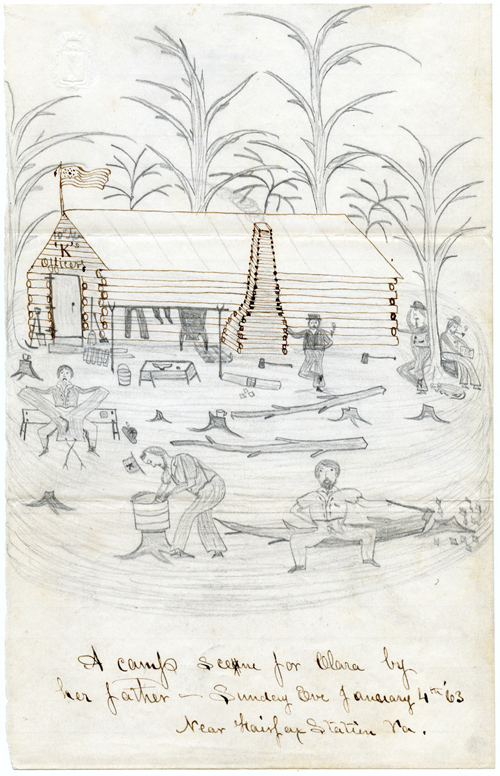
According to the 1860 Lewiston (Maine) census, the 32-year-old Nye was a factory “overseer,” with real estate worth $1,000. He managed the Bates Mill, a massive textile mill adjacent to the Androscoggin River.
With Nye lived his wife, 27-year-old Charlotte, whom he had met in Hallowell on the Kennebec River. Absolutely smitten with her throughout their marriage, Nye called her “Charlie” and addressed his wartime letters to her accordingly. The Nye household included Georgianna (7), Clara (4), Grace, (1), and 60-year-old Sarah Hussey, Charlotte’s mother. Tragedy struck the family when Georgianna, now 8, died on January 18, 1861.
In late April her father joined the 1st Maine Infantry Regiment as the second lieutenant of Co. K, drawn primarily from the Lewiston Zouaves. Nye mustered on May 3, 1861. A measles outbreak quarantined the three-month regiment, however, and the 1st Maine did not leave Portland by train until June 1.
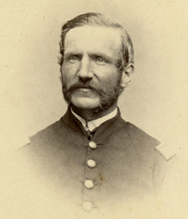
Left in Washington, D.C. during the Manassas debacle, the regiment left the capital by train on July 31 and mustered out in early August. Irritated that the regiment had not served a full two years (as would the 2nd Maine Infantry), Maine Governor Israel Washburn Jr. created the 10th Maine Infantry Regiment and recalled the 1st Maine lads to the colors.
Among them was Nye, now 33 and standing 6 feet tall with gray eyes, gray hair, and a light complexion. Commissioned captain of Co. K, he mustered on October 4, with his two-year enlistment backdated to May 3.
A Manassas veteran, Henry Martin Binney came from Somerville, Massachusetts to muster with the 10th Maine on October 26. A 30-year-old clerk standing 5-7, he had black eyes, black hair, and a dark complexion. Commissioned a second lieutenant in Co. D, he reported to Capt. George W. West, another Somerville resident.
Binney thought highly about himself, an opinion not shared by certain other 10th Maine comrades, such as budding regimental historian Sgt. Maj. John M. Gould. West transferred to the 17th Maine as its major in July 1862. Binney discovered that 1st Lt. John Beardsley did not want the Co. D captaincy — and that West had recommended 1st Sgt. Edward Brackett (a Bostonian) for that position.
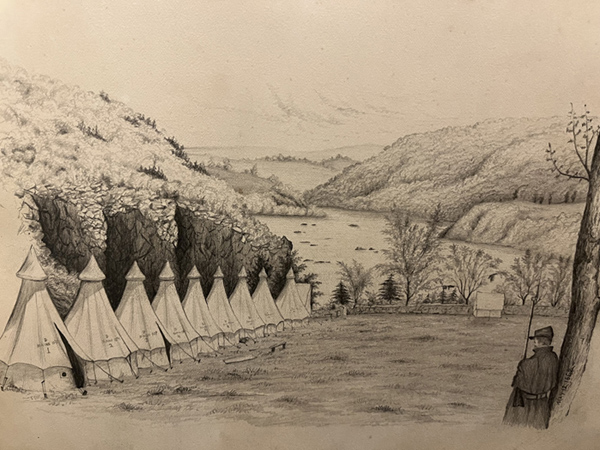
Writing Governor Washburn, Binney praised Brackett as “an accomplished and honorable gentleman” who “deserves the rank of a Simple Lieutenant, the rank of a gentleman.” Binney was “entitled” to the promotion created “by a vacancy in a higher position, which may occur in my own company.” If not made captain, “I should deem it a slight, an injustice and a discredit … in regard to my competency in military circles and would tend to inure me to a great extent.” He made first lieutenant, effective July 15, 1862.
Through late summer 1862 the 10th Maine performed garrison duty at different posts, including Relay House and Harpers Ferry. A talented artist, Binney drew detailed sketches depicting camp life and other scenes. One sketch shows the Harpers Ferry engine house, its exterior damaged by war.
In another sketch, Binney depicts Co. D’s Sibley tents lined up in a stonewall-bordered pasture that overlooks a river flowing between forested hills. A greatcoat-clad Union sentry stands watch. Natural surroundings suggest the Potomac River near Harpers Ferry. The exact location is unknown, but 1st/10th/29th Maine historian Nicholas Picerno thinks it could be Bolivar Heights.
Frequently writing Charlotte, George Nye occasionally included a sketch he had drawn of military life. Writing from the 10th Maine’s camp at Fairfax Station, Virginia on Sunday evening, January 4, 1863, he included with a letter a sketch of “A camp scene for Clara by her father.”
Set outside the log cabin identified as home to Me ‘K’ Officers,” the sketch depicts Nye leaning against the wooden chimney while watching his men wash and mend their clothes or read a letter. One soldier sits atop the felled tree brought down by the ax in his left hand. Smoking a long pipe, Nye stands with his right leg crossed in front of his left leg. Laundry hangs from a nearby rudimentary clothesline. Hardwood trees stand leafless behind the cabin, from which flies an American flag. The sketch is rare because Nye was not an artist by nature, Picerno noted.
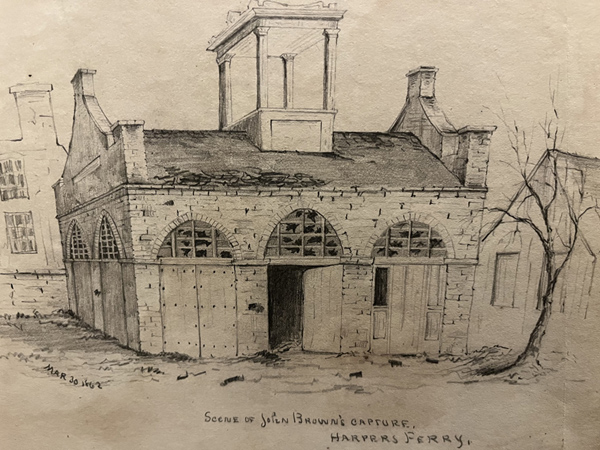
Binney gave his sketchbook to Edward Brackett, his perceived competitor for Co. D’s captaincy. “The sketchbook was left in Brackett’s baggage in the 10th Maine’s wagons” when the regiment garrisoned Winchester, Virginia in late May 1862, Picerno said. Troops commanded by Gen. Thomas “Stonewall” Jackson attacked the town on May 25.
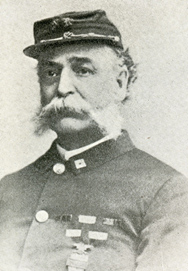
The 10th Mainers were among the last Union troops to vacate the city,” Picerno said. “Brackett’s sketchbook was found in a wagon by a lieutenant in the 58th Virginia Infantry. He would send the book home to his family near Roanoke, Virginia.” The sketchbook came into Picerno’s possession in the 21st century.
Binney was serving as an aide to Harpers Ferry commander Dixon S. Miles when he surrendered his garrison on September 15. According to Picerno, “Binney was dismissed from the army on December 30, 1862, for conduct related to the surrender of Harper’s Ferry in September.”Enlisting as Martin Binney in Co. B, 28th Massachusetts Infantry in mid-March 1864, he made captain in May, suffered several wounds during the Overland and Petersburg campaigns, and mustered out in December.
Mustering out with the 10th Maine in May 1863, Nye joined the 29th Maine Infantry as captain, Co. K., in November. Promoted to major in October 1864, “he was severely wounded in the mouth” at Cedar Creek,” according to a biography. Commissioned the 29th Maine’s colonel in December, Nye commanded the regiment during post-war occupation duty in Georgia and South Carolina.
Sources: 1860 U.S. Census for Lewiston, Maine; Georgianna Nye death notice, Maine Vital Records, 1760-1921, Maine State Archives; Annual Report of the Adjutant General of the State of Maine, 1861, Stevens & Sayward, Augusta, ME, 1862, pp. 17-18, Appendix D, pp. 58-59, 445; Brian F. Swartz, Maine at War, Vol. 1: Bladensburg to Sharpsburg, Maine Origins Publications, Brewer, ME, 2019, pp. 25, 76-77; Henry H. Nye and Henry Martin Binney soldiers’ files, MSA; 2nd Lt. Henry M. Binney to Governor Israel Washburn Jr., April 27, 1862; Annual Report of the Adjutant General of the State of Maine, 1864-1865, Stevens & Sayward, Augusta, ME, 1866, p. 430